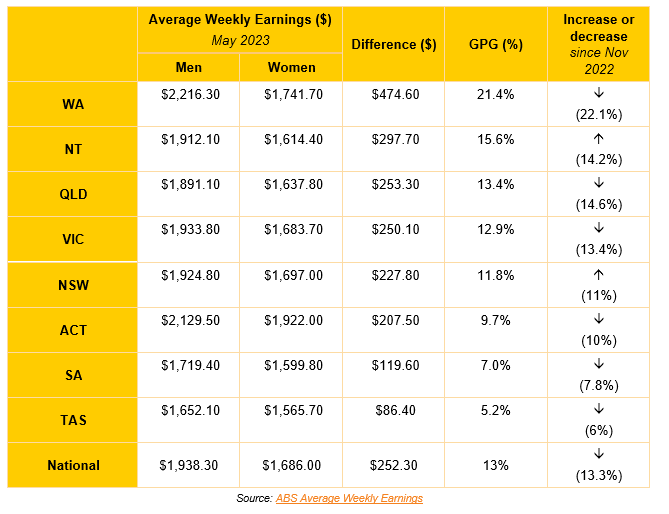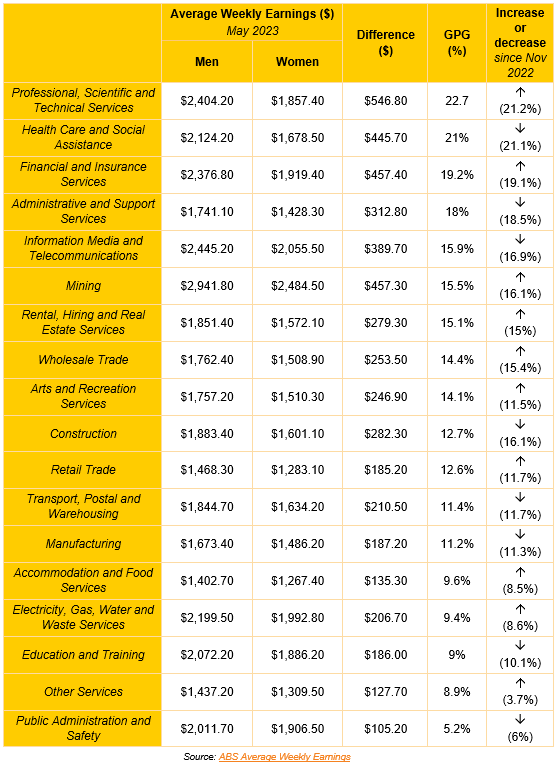New ABS data released today shows Australian women are earning, on average, $13,120 less in their annual base salary, than men each year.
The new national gender pay gap of 13% is an 0.3 percentage point decrease on figures released in February this year, and indicates that, on average, for every $1 men earn in Australia, women make 87 cents. The ABS attributes the reduction to an improvement in the income of women in typically lower paid female-dominated industries such as education and training and health care and social assistance.
While this is a significant drop in the national gender pay gap, representing the lowest it has ever been, Workplace Gender Equality Agency (WGEA) CEO Mary Wooldridge said that now is not the time for Australia to be resting on its laurels.
“As we celebrate today the incredible performance by the Matildas and the fact their semi-final was the most watched TV event in Australian history, we are also energised by the lowest ever national gender pay gap,” Ms Wooldridge said.
“This momentum is a springboard for renewed action for employers to prioritise gender equality and ensure that we continue to work towards closing the gender pay gap.”
The data shows that all industries and in every State and Territory in Australia, women are earning on average less than men. The gender pay gap increased in 10 out of 18 industries over the last six months, but we saw significant decreases in some sectors, particularly construction which had a 3.4 percentage point decrease. Information, media and telecommunications, and education and training also had notable decreases, showing that when industries work to improve gender equality it is possible to make gains.
Employers can no longer ignore their gender pay gap. From 2024, the gender pay gap for organisations with a workforce of 100 or more employees is going to be on the public record.
“Next Friday, 25 August is Equal Pay Day, marking the 56 days from the end of the financial year that women have to work to earn the same, on average, as men,” Ms Wooldridge said.
“This year we are calling on employers to recognise that ‘what’s missing matters’ in a whole range of situations, and particularly the missing pay for women matters. And we are asking employers to do something about it.
“Employers have a key role to play in addressing the entrenched gender norms and stereotypes that are a barrier to women’s progression or full participation in the workplace,”
“With dedicated, intentional action to address the gender pay gap in their organisation, Australian employers will contribute to accelerating progress to close the national gender pay gap.”
Gender pay gap (by state/territory)
Gender pay gap (by industry)
Media contact
Lucy Bradlow, Communications & Campaigns Executive Manager
About WGEA
The Workplace Gender Equality Agency (WGEA) is an Australian Government statutory agency charged with promoting and improving gender equality in Australian workplaces.
Read more and explore the full dataset for your industry at www.wgea.gov.au
The ABS gender pay gap is based on base salary for full time workers only. Find out how it differs by state, industry and sector.
The difference between the average earnings of men and women in the workforce.
The gender pay gap is a simple calculation that always stays the same, no matter what 'pay' data you use.


